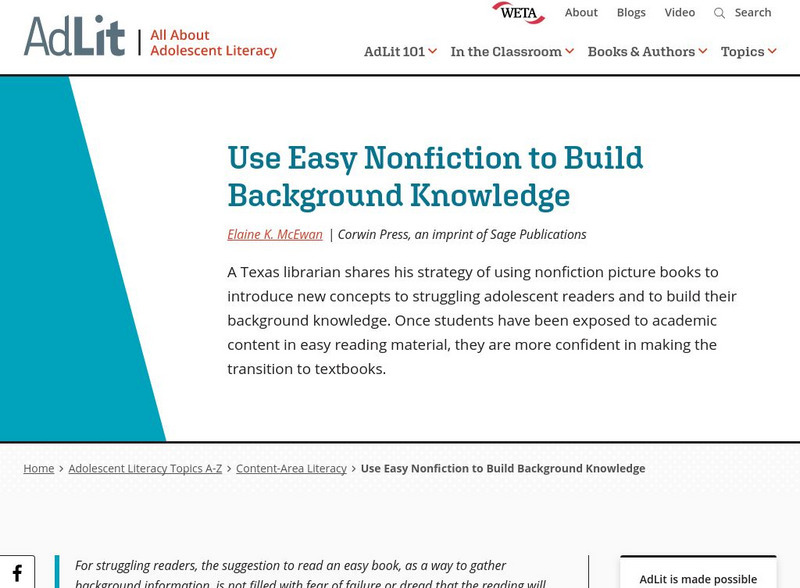Hi, what do you want to do?
Curated OER
The 15 Circles
Students listen to the problem and think about it, discuss, and work in groups on the solution. They get into groups and solve. They then write down their solutions and report back to the class.
Curated OER
Easy Bias-Covered Curves
Students watch a demonstration on how to make easy-bias covered curves. Using that information, they practice making their own with different types of materials. They share their creations with the class to end the lesson.
Curated OER
Itty-Bitty Teeny-Tiny Word Books
In these worksheets, 1st graders will construct two itty bitty word books. Students will create a book of words pertaining to the zoo and the farm and color the pictures in each.
Curated OER
The Mysterious Person
Students each create a small piece of a larger picture. When assembled the final piece match a photograph of a famous individual.
Curated OER
Planning a Railroad
Young scholars use a topographical map to plan a route from Doknner Summit to Truckee, then compare it to the route selected by Theodore Judah.
Curated OER
Bead It!
Fourth graders use colored beads in two problems and explore the use of proportional reasoning as a problem solving method. Working Students, in groups, explain their reasoning strategies orally, and through drawings.
Curated OER
Making Birthday Calendars for Community Organizations and Businesses
Students create birthday calendars using The Print Shop computer program. They produce and market a product, replicating a work environment.
Curated OER
Everyday Objects as Art
Students interpret works of art by Keith Haring, Robert Rauschenberg, and Marcel Duchamp.
Curated OER
Letters
Young scholars read letters the could have been written by Robert E.Lee and his friend John giving students an ideas of what young scholars from a different era thought of George Washington. They discuss history from a child's view point.
Curated OER
Lesson Plan on the Theory of Comparative Advantage
Twelfth graders practice using new vocabulary related to economics. They discover how to calculate comparative and absolute advantage. They also read different articles about the topic.
Curated OER
Firstgov for High Schoolers
Students inspect the FirstGov.gov website to complete a worksheet about Federal sites and organizations. They increase their practical use of Internet research skills.
Curated OER
Firstgov for Kids
Students examine kids.gov, FirstGov for Kids website, which provides links to both Federal kids sites and sites from other organizations. They complete a worksheet by finding answers at the website.
Curated OER
Direct and Cross-Examination
Learners continue to prepare for their mock trial. In groups, they are introduced on how to properly cross and direct examine someone using the techniques. They practice each technique on one another and compete against other groups in...
Curated OER
What Was It Like To Live in Tudor Times?
Young scholars compare and contrast the lives of the rich and poor people in Tudor times. Students observe photographs of Tudor life. They investigate word clues describing the lives of the people. Young scholars create a presentation...
Curated OER
Memorizing Techniques
Students explore a variety of nmemonic devices, methods and techniques to help improve their memories. They brainstorm a list of things they find difficult to remember on their own first. In pairs they work on memory tricks by quizzing...
Curated OER
Conditional Verb Quiz
In this verb tense quiz worksheet, students read 10 statements. They change 20 verbs, that are shown in parentheses, in 10 sentences to the conditional tense.
Curated OER
Los Angeles Throughout the Years
In groups, 4th graders are given a recent decade to focus on and its impact on Los Angeles and to see how the city has changed over time.
Curated OER
Los Angeles Throughout the Years
Fourth graders study the history of the city of Los Angeles, investigating its variety of cultural traditions. They develop expertise on one specific decade in LA history.
Khan Academy
Khan Academy: Interpreting a Confidence Interval for a Mean
After we build a confidence interval for a mean, it's important to be able to interpret what the interval tells us about the population and what it doesn't tell us.
AdLit
Ad lit.org: Use Easy Nonfiction to Build Background Knowledge
A Texas librarian shares his strategy of using nonfiction picture books to introduce new concepts to struggling adolescent readers and to build their background knowledge. Once students have been exposed to academic content in easy...
PBS
Pbs Learning Media: Sesame Street: Trauma
Trauma can destroy a child's sense of self-worth and confidence in their abilities. Developing new skills, such as balance and focus, can help build it back. These resources offer a variety of ideas to help build a child's self-esteem...
Teaching American History
Teaching American History: From Bullets to Ballots Chapter 3
An Anxious Confidence, The Anxieties of a New Republic, Chapter 3 of From Bullets to Ballots by John Zvesper explores the energy throughout the new nation as the democracy evolved.
Khan Academy
Khan Academy: Interpreting a Z Interval for a Proportion
Once we build a confidence interval for a proportion, it's important to be able to interpret what the interval tells us about the population, and what it doesn't tell us. Let's look at few examples that demonstrate how to interpret a...
Khan Academy
Khan Academy: Reference: Conditions for Inference on a Proportion
When we want to carry out inferences on one proportion (build a confidence interval or do a significance test), the accuracy of our methods depend on a few conditions. Before doing the actual computations of the interval or test, it's...
Other popular searches
- Building With Confidence
- Confidence Building in Math
- Building Up Water Confidence
- Building Confidence




























